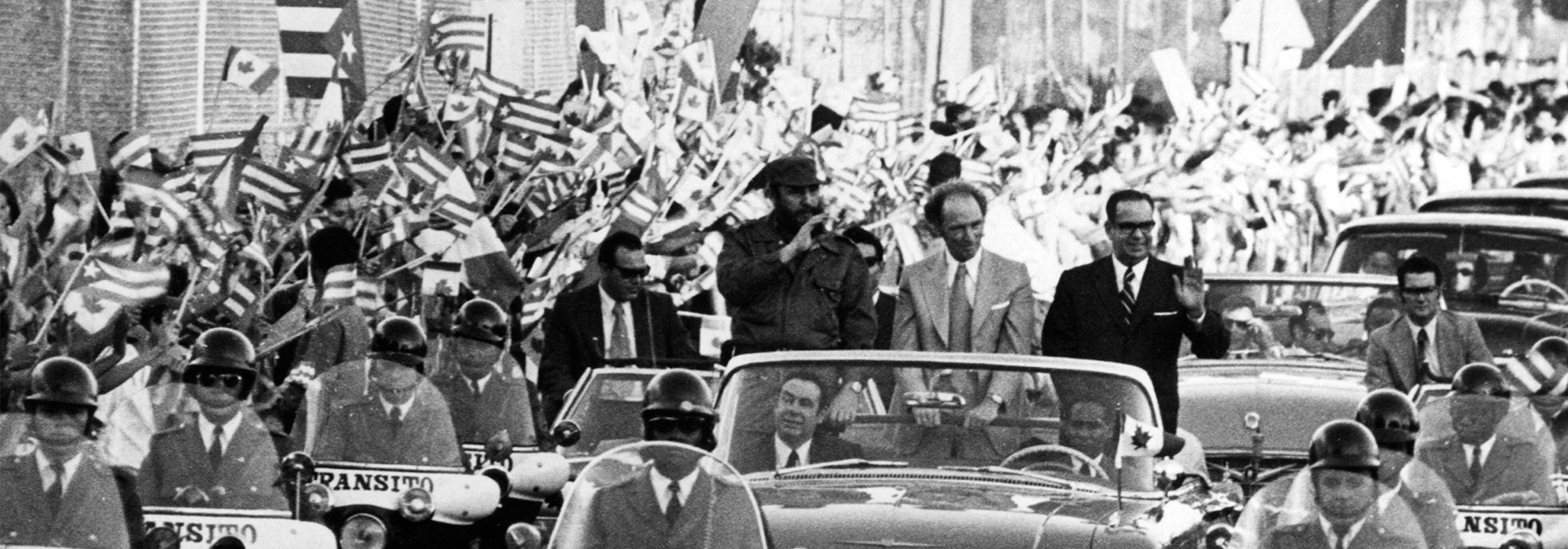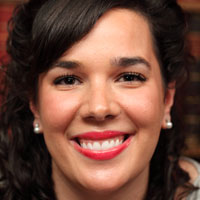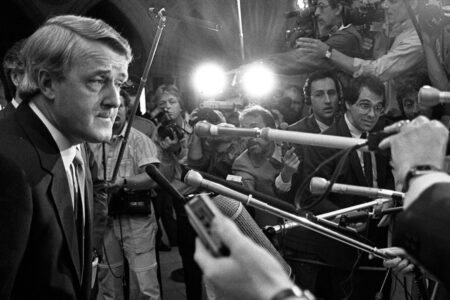
In May 1968, Pierre Trudeau announced his decision to conduct a thorough review of Canada’s foreign and defence policies. It would take 25 months to complete and would absorb the attention of senior officials in nearly every government department and of citizens, academics and nongovernmental organizations alike. The ultimate result was published on June 25, 1970, in six colourful booklets. The first and longest dealt with Canadian foreign policy in general, two were subject specific, on the United Nations and international development, and three were devoted to geographical areas (Europe, Latin America and the Pacific).
The country finally had a Foreign Policy for Canadians. Half a century since undergoing the review, does it need another?
These reviews are more than intellectual exercises; they make us think about our foreign policy in a more systematic way. After the Second World War, Canadians saw themselves as active members of the Commonwealth, the UN and the North Atlantic Treaty Organization, and as close allies and partners of the United States. In 1970, Canada added a focus on the grouping of nations of French expression in la Francophonie. But Foreign Policy for Canadians presented a view of the world much more specifically from a Canadian vantage point, and it was more than just an affirmation of traditional foreign policy concerns. Certainly security, independence and prosperity were included, but so were policies that would ensure “all Canadians will see in the life they have and the contribution they make to humanity something worthwhile preserving in identity and purpose.”
So going forward, as outlined in the first booklet, the government would craft policies around six themes: promoting social justice, enhancing quality of life, safeguarding sovereignty and independence, fostering economic growth, working for peace and security, and ensuring a harmonious natural environment.
Of these, Trudeau’s government seemed to prioritize the first three themes. They complemented Trudeau’s 1968 campaign promise for a just society, and for a Canada truly bilingual, multicultural and independent from both the United States and Britain. It was Trudeau’s search for new approaches and new opportunities that led him to recognize the People’s Republic of China, increase foreign aid and establish closer relations with developing nations, like India and Cuba.
The decision to conduct the policy review was Trudeau’s — his predecessor, Lester Pearson, had just produced a report in support of the status quo and remaining a “helpful fixer.” But the international environment was changing, and Canada’s relative political influence was waning. Western Europe had recovered from the war and new countries were joining the international community. From the original 51 member states, the UN’s membership had ballooned to 126 by the spring of 1970.
The mistake in 1970
But the foreign policy review had one major flaw: Canada’s relations with the US were not explicitly considered in any of the booklets. Officially, the government stance was that Canada’s relations with its southern neighbour were so pervasive they could not be isolated for study. Indeed, in virtually every sector, from imports to travel to natural resources to mass media, America’s influence was apparent, and often dominant.
Unofficially, the government had handed over economic matters related to the US for consideration by a separate body under the direction of Herb Gray, at the time Canada’s minister of national revenue. Canadians eagerly anticipated word of the government’s plans to handle American money and culture, which were seemingly hollowing out the country.
Finalizing Gray’s report took longer than expected, and cabinet documents were leaked in what was dubbed the Canadian version of the Pentagon Papers. What the 1972 report called for was a screening agency to monitor foreign investment and foreign takeovers. The task force wrote “foreign,” but it meant “American.”
The archives show us that the release of the report was delayed when Richard Nixon, US president at the time, abruptly imposed a 10 percent import surcharge that would cost Canadians billions of dollars. Officials were worried any action on foreign investment would be perceived as retaliation and only make matters worse for Canada’s most important trading relationship.
Nixon still said at a White House dinner for Trudeau: “Canadians and Americans get along reasonably well, very well as a matter of fact.” This sounds like something Donald Trump would say. In fact, Trump has been even more direct in professing his love for Canada, at the same time as 25 percent steel and aluminum tariffs cost Canadians billions in lost export revenue — while the governments of Canada, the US and Mexico were negotiating a new free trade agreement.
In 20th-century protectionism, the goal was convincing Canadians of the benefits of open trade between Canada and the US. Now the goal is convincing Americans. The Canadian government has focused on building relationships inside the US administration and has deployed cabinet ministers, elected representatives, premiers, business leaders and union presidents across the US to meet with politicians. These envoys remind Americans that their economic prosperity depends in large part on trade with Canada, and then aim to convince them to lobby the White House and Congress — at first, not to destroy NAFTA, and now, to ratify the new deal. And rather than handing off US economic matters to a committee for study, the current Trudeau government has created a “war room” to deal with the unpredictable actions of its southern neighbour.
Just as NAFTA needed updating for the digitized world, so does our understanding of how the challenges and opportunities of the future will fit in the Canada-US bilateral relationship.
Rethinking the bilateral relationship
The closest thing Justin Trudeau’s Liberals have to a foreign policy review is the speech Minister of Foreign Affairs Chrystia Freeland presented in 2017. The principles it outlined echo previous iterations of Canadian foreign policy as far back as 1947, when Minister of External Affairs Louis St. Laurent outlined Canada’s values, including respect for the rule of law and accepting international responsibility. Freeland has frequently referenced her admiration for St. Laurent, and Trudeau has also acknowledged St. Laurent’s speech as inspiration for his government’s foreign policy.
On the one hand, these signal events of 1947, 1970 and 2017 were optimistic openings for Canada during moments of changing international relations. On the other, 1970 and 2017 saw moments of protectionism, with America leveraging its power and thrusting “America first.”
Like the absence of a booklet about the United States in 1970, Freeland’s speech obfuscates the obvious; the words multilateral, global and international are used five times more than any mention of the US. In one of the direct references, Freeland says that “although we have an incredibly good relationship with our American friends and neighbours, such a dependence would not be in Canada’s interest.” She’s speaking of defence in this instance, but this dependence — or southern exposure, to be more generous — is an immutable fact. It is a consistent feature of Canada’s foreign policy, as is Canada’s willingness to pursue relationships with as many countries as possible. This is the crux of the Third Option policy in the 1970s and of what is now known as trade diversification, with its own minister.
Starting in the 1960s, the Canadian government began to accept greater responsibilities as a nation in the Americas — Canada became a permanent observer at the Organization of American States in 1972 — but also as an Arctic nation and a Pacific nation. Widening the horizons, like diversifying trade, was never meant to lessen ties with the US; rather, it was intended to limit increasing dependence on the American economy.
The ranking of the six foreign policy themes, as shaped by the usual constraints — time, money, public opinion — determined Canada’s foreign policy back then. If Pierre Trudeau’s government prioritized his just society and quality of life, Justin Trudeau seems more focused on the other themes. His carbon tax is a clear example of the government’s commitment to a harmonious natural environment, and the peacekeeping mission in Mali and the campaign for a UN Security Council seat check boxes under peace and security. Regarding economic growth, as it was 50 years ago, the US will be Canada’s principal economic partner for the foreseeable future.
Time for a new review
Canadians are often reluctant to put the US front and centre, not because it is insignificant but because its importance is very great indeed — and because Canadians don’t always want to be reminded of that. St. Laurent said as much: “It is not customary in this country for us to think in terms of having a policy in regard to the United States.” But this relationship should not be siphoned off to a committee or seen as too omnipresent to study.
The International Joint Commission was established in 1909 to handle boundary-waters disputes, but it can address any issue between Canada and the US. Over a century since its founding and 50 years since the foreign policy review, maybe there are new ways of doing things. As Pierre Trudeau once said, in a statement that Trump would likely agree with, “The only constant factor to be found in my thinking over the years has been opposition to accepted opinions.” There is room to rethink this relationship, encompassing politics, economics, defence, the border and the other myriad issues that define it.
The most recent foreign policy review was interrupted by 9/11, and when it was completed four years later, a new Conservative government ignored it. But the terrorist attacks and the closing of the border underscored lessons for Canada about the movement of goods and security. While there is always a risk of reviews being shelved, the changing politics of international affairs and the volatile nature of US politics right now make it incumbent on whichever party holds power after October 2019 to analyze and prioritize the country’s foreign policy objectives.
Whether the criticism is from those who think the government is going too far in redefining the parameters of Canada’s role on the international stage or from those saying it’s not going far enough, and whether they were saying it in 1970 or today, they are pointing to a lack of strategy. But this is not the first time Canada has dealt with a protectionist American administration or reckoning with what it means to not have a special relationship with the US.
There are one-off projects the Canadian government could adopt, like a special agency for trade policy along the same lines as the office of the United States Trade Representative, as was suggested in 2005. But policy coherence will be achieved only if we put everything on the table to debate and consider.
A good place to start, to borrow from John Kennedy’s famous exhortation in his inaugural address, might be not “foreign policy for Canadians” but “Canadians for foreign policy.” There are calls for the Trudeau government to fund Canadian studies abroad and to send more students for learning abroad.
Canada’s national security and economic interests and our role on the global stage are defined by our ties to the US. If we’re recycling foreign policy values, it’s worthwhile to also reflect on the six books and six themes of Canada’s foreign policy past during Nixon’s iteration of America first. We need to re-examine the bilateral relationship, keeping trade front and centre, and we should do this through a foreign policy review. Whether simply resetting the relationship or reducing dependence, these are national projects that will take years, and we should have an approach for doing so: maybe even a red, white and blue booklet.
Photo: Thousands of Cuban people along the streets in Havana greet Prime Minister Pierre Eliott Trudeau has he drives through the city January 26, 1976. Along with him in an open car are Commander in chief Fidel Castro and president of Cuba Osvaldo Dorticos. Trudeau’s foreign policy included establishing closer relations with Cuba. CP Photo, by Fred Chartrand.
Do you have something to say about the article you just read? Be part of the Policy Options discussion, and send in your own submission. Here is a link on how to do it. | Souhaitez-vous réagir à cet article ? Joignez-vous aux débats d’Options politiques et soumettez-nous votre texte en suivant ces directives.









